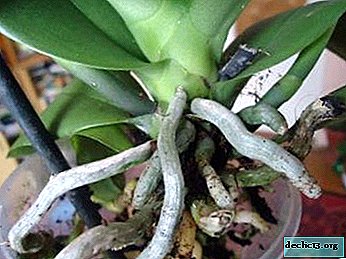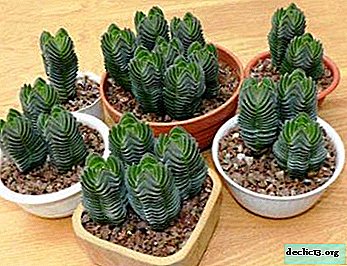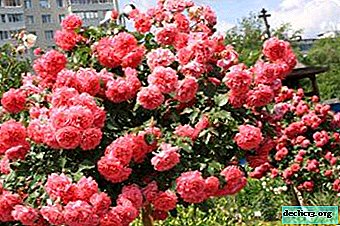Cactus Mammillaria gracilis - description with photos, tips on growing and combating diseases

A widespread cactus species among amateurs is Mammillaria gracilis, which has an interesting breeding paradox.
Cactus growers often breed young uterine forms, which practically do not bloom and die very quickly, giving all their strength to the young.
However, a real adult cactus is a great specimen for the collection.
Botanical Description
Mammilaria (Mammilaria) is a genus of plants belonging to the Cactaceae family. They take their origin from the south of the USA, Mexico and the Caribbean islands. All species - small green cacti of various shapes - spherical, disk-shaped, cylindrical, etc. They differ from many others by the presence of not ribs on the surface, but tuberculosis - small papillae located in a spiral. Mammillaria flowers are located on the buds between the tubercles. From the same buds, branching of cacti occurs.
Mammillaria is slender, or elegant, or mammillaria gracilis (Mammillaria gracilis) is a common type of cactus. The native land of the plant is Hidalgo, Mexico. It is very popular with cactus growers, although most often you can find not an adult, but a juvenile form.The stems are cylindrical, saturated green, can reach 4 cm in diameter. With age, the stems bend and become prone, and with improper care lose their decorative effect. This species tends to cluster from a very early age, forming the so-called colonies.
The spines are adjacent, white or yellowish-white, a little less than 1 cm long. Up to 20 spines can grow from one bunch. The flowers are about 1.5 cm long, with white petals. When fully opened, the diameter of the flower is approximately equal to its length.
It differs from other species by the length of spines, the flower, and the tendency to form colonies due to early branching. In most mammals, the processes appear below the stem and from the roots, slender mammals form the so-called “babies” throughout the stem and closer to the apex.
Plant photo
Here you can find photos of slim Mammillaria:





How to care?
Mammillaria is not a capricious plant, however, it also has its own specific subtleties in care. Many flower growers cultivate exclusively juvenile stages, without bringing plants to competent care to more adults. That is why it is very difficult to meet adult mammillaria gracilis, despite the popularity of this species.
Temperature
Since cacti are naturally native to hot countries, they love warmth. In the summer, the optimum temperature will be + 20-25 degrees. At the same time, mammillaria easily tolerates hot, sunny weather, although you should not leave the plant in the sun in the heat - the stem can get sunburn. In winter, it is necessary to lower the temperature to + 10-12 degrees. At this time, the plant goes into a dormant stage and builds up strength for subsequent flowering.
Watering
Mammillaria requires a small amount of water - the cactus is sensitive to waterlogging. In winter, watering is more likely prohibited, you can occasionally spray a plant from a spray bottle - no more than once a month. In summer, the plant is watered no more than once every one and a half to two weeks. If the soil dries out strongly (in dry and hot weather), you can spray mammillaria once a week between irrigations.
Shine
The plant is photophilous, but the location on a sunny day under direct rays is not recommended. A little shading on the hottest hours will only benefit the cactus. The optimal location for mammillaria is the east or west window. In winter, the cactus will have enough of that sunlight, which can give a shortened day.
Soil composition
 You can purchase special soil for cacti. You should pay attention to the composition - it should be non-greasy mineral soil, poor in organic matter. The substrate should be light and friable.
You can purchase special soil for cacti. You should pay attention to the composition - it should be non-greasy mineral soil, poor in organic matter. The substrate should be light and friable.
You can prepare the soil yourself. For this:
- Clay earth, coarse sand and peat crumb in a ratio of 1: 1: 1 are taken.
- To the mixture is added finely crushed charcoal, fine expanded clay, crushed brick into crumb, or other loosening components.
Pruning
With proper care, mammillaria gracilis does not need pruning. With a lack of light or excessive watering, the cactus lengthens and curls, losing its decorative effect. This is the mistake of many cactus growers. In this case, pruning will not be an option - it will not be possible to return attractiveness to such a cactus.
Sometimes pruning is used to preserve the curved cactus mother plant, when the roots are damaged by gray rot or the trunk is damaged by other diseases.
- A sharp knife (preferably treated with alcohol) cuts off the top of the cactus until the first curvature. Usually this is a hat 5-6 cm high.
- Slices on hemp and trimmings are processed with crushed wood or activated carbon. The cut off cap is sometimes dusted with a rooting agent.
- The slice is left to dry for several days in a dark, dry place. You can try to root the resulting stump from the side of the fall.
- After 2-3 days, the cut tip is placed in a container of water so that there is a small space between the surface of the cut and the water.
- After the formation of the first roots, stretching to the water, the cut is laid on the ground for more firm rooting.
Top dressing
During active growth (from mid-spring to October), the plant is fed no more than once a month. Special fertilizers for cacti, mineral, are applied along with watering to the soil away from the roots, so as not to get accidental burns of the root system.
Pot
Capacity for mammillaria is selected taking into account the size of the root system. Small ceramic bowls are suitable for young cacti, wide and shallow for older adults. Material - ceramics, plastic is undesirable, because at high temperatures in the sun it can release substances harmful to the cactus into the soil.
Transfer
 Young plants are transplanted once a year, adults (from 5-6 years) - every 2-3 years as the root system develops and soil degradation.
Young plants are transplanted once a year, adults (from 5-6 years) - every 2-3 years as the root system develops and soil degradation.
- Transplantation is carried out in early spring before the stage of active growth (March-April) after flowering.
- A container is prepared, at the bottom of which a small drainage layer is placed. It falls asleep on 2/3 layer of the substrate, left to dry for several days.
- The plant is not watered before transplanting for about two weeks.
- On the day of transplantation, the cactus is gently shaken out of the old pot. All the earth is removed, the root system is inspected.
- The cactus is placed in a new container and sprinkled with roots on the remaining third of the substrate.
- A pot of transplanted cactus is placed in a cool dark place for several days.
- You can water mammillaria 2-3 days after the transplant.
Wintering
- The rest period is October-March.
- The plant is practically not watered - you can spray it in dry air no more than once a month.
- Temperature is not above +12 degrees.
- Light mode - winter western or eastern window.
- Do not touch the pot with the cactus, do not move or rearrange it - the plant needs complete rest.
Breeding
Mammillaria is propagated by processes of children or seeds. Seeds are obtained rarely and difficultly, therefore, they are often propagated by children.
Seeds
Propagation by seeds gives different plant genotypes, which subsequently allows the seeds to be independently bred. Mammillaria seed formation occurs during cross-pollination from different specimens. Along with this, it is quite difficult to acquire seeds.
- Seeds are soaked in a light pink solution of potassium permanganate for 2-3 days.
- Next, the seeds are placed in a container with wet river sand and lightly sprinkled with them.
- The container is covered with glass or polyethylene, forming a kind of greenhouse.
- Once a week the greenhouse is ventilated, once every two weeks - the soil is sprayed.
- After emergence, the greenhouse is gradually removed, allowing juveniles to get used to the temperature and humidity conditions.
- Transplanted juveniles after the appearance of the first thorns.
Kids
 Reproduction by children is a more effective and quick way to quickly get juvenile stages that cacti growers appreciate. To obtain more valuable adult plants, the seed method is more often used.
Reproduction by children is a more effective and quick way to quickly get juvenile stages that cacti growers appreciate. To obtain more valuable adult plants, the seed method is more often used.
- Children with the emerging “seeking” roots are carefully separated from the mother plant.
- Separated children are sprinkled on slices with powdered charcoal and allowed to dry in a cool dark place for several days.
- The resulting shoots are planted in moist soil for cacti.
- A pot of seedlings is placed in a warm, shaded place.
- After the first thorns appear, each cactus is transplanted into separate pots.
Diseases and Pests
Dangerous pests are spider mites, red mites, and catus insects. In the fight against them, insecticides, a solution of actellica, tanreka, vertimek are effective.From folk remedies for pests, a soap solution - a pot helps:
- The window sill is treated with a foamy soapy solution, the plant itself is sprayed.
- Soap foam is washed off from the cactus after 3-4 hours.
Treatment with insecticides should be carried out at least 3 times. Pest eggs are especially resistant to damage.
When overflowing, a frequent unwanted guest is gray rot. Only pruning can save the cactus, transplanting in most cases is powerless.
Similar views
- Mammillaria Wild - a small thick cactus with golden spines. Blossoms like slender mammillaria flowers, straw yellow or golden white.
- Mammillaria Carmen - differs from Gracilis in cream flowers and longer white needles. Root shoots.
- Mammillaria Baum - A rounded cactus with a large number of white spines, characterized by bright yellow flowers.
- Mammillaria elongated - a view that is often confused with the elegant. Adult cacti are elongated, with white adjacent spines. Mammillaria gracilis takes a similar form with improper care. It features bright red flowers forming a crown on the stem.
- Proliferator Mammillaria - has an elongated stem with yellowish spines, the flowers are wide whitish-yellow.
Slim Mammillaria does not need special care and is suitable even for beginners. The mistake lies in the desire to breed as many cacti of the same species as possible, propagating the children obtained and not letting the cactus bring out its uniform spherical colony. With proper care, adult spines will begin to form, and then flower buds and flowers. Such a plant lives for a very long time and annually pleases with small winter flowers.

















